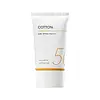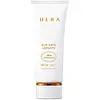What's inside
What's inside
 Key Ingredients
Key Ingredients

 Benefits
Benefits

 Concerns
Concerns

 Ingredients Side-by-side
Ingredients Side-by-side

Water
Skin ConditioningZinc Oxide
Cosmetic ColorantCyclohexasiloxane
EmollientButyloctyl Salicylate
Skin ConditioningPropanediol
SolventPropylheptyl Caprylate
EmollientPolyglyceryl-3 Polydimethylsiloxyethyl Dimethicone
Skin ConditioningDicaprylyl Carbonate
EmollientIsododecane
EmollientCaprylyl Methicone
Skin ConditioningDioctyl Adipate
Polyethylene Naphthalate
Methyl Methacrylate Crosspolymer
Melaleuca Alternifolia Leaf Extract
PerfumingHydrogenated Lecithin
EmulsifyingDisteardimonium Hectorite
StabilisingMagnesium Sulfate
Titanium Dioxide
Cosmetic ColorantTriethoxycaprylylsilane
1,2-Hexanediol
Skin ConditioningPolyglyceryl-2 Dipolyhydroxystearate
Skin ConditioningPolymethylsilsesquioxane
Lauryl Polyglyceryl-3 Polydimethylsiloxyethyl Dimethicone
Skin ConditioningGlyceryl Caprylate
EmollientCaprylyl Glycol
EmollientGlycerin
HumectantEthylhexylglycerin
Skin ConditioningDipropylene Glycol
HumectantPanthenol
Skin ConditioningCetearyl Olivate
Sorbitan Olivate
EmulsifyingTocopherol
AntioxidantButylene Glycol
HumectantCeramide NP
Skin ConditioningAllantoin
Skin ConditioningParfum
MaskingWater, Zinc Oxide, Cyclohexasiloxane, Butyloctyl Salicylate, Propanediol, Propylheptyl Caprylate, Polyglyceryl-3 Polydimethylsiloxyethyl Dimethicone, Dicaprylyl Carbonate, Isododecane, Caprylyl Methicone, Dioctyl Adipate, Polyethylene Naphthalate, Methyl Methacrylate Crosspolymer, Melaleuca Alternifolia Leaf Extract, Hydrogenated Lecithin, Disteardimonium Hectorite, Magnesium Sulfate, Titanium Dioxide, Triethoxycaprylylsilane, 1,2-Hexanediol, Polyglyceryl-2 Dipolyhydroxystearate, Polymethylsilsesquioxane, Lauryl Polyglyceryl-3 Polydimethylsiloxyethyl Dimethicone, Glyceryl Caprylate, Caprylyl Glycol, Glycerin, Ethylhexylglycerin, Dipropylene Glycol, Panthenol, Cetearyl Olivate, Sorbitan Olivate, Tocopherol, Butylene Glycol, Ceramide NP, Allantoin, Parfum
Water
Skin ConditioningC12-15 Alkyl Benzoate
AntimicrobialEthylhexyl Methoxycinnamate
UV AbsorberButylene Glycol
HumectantPropanediol
SolventDiethylamino Hydroxybenzoyl Hexyl Benzoate
UV FilterBis-Ethylhexyloxyphenol Methoxyphenyl Triazine
Skin ConditioningTitanium Dioxide
Cosmetic ColorantDimethicone
EmollientTrisiloxane
Skin ConditioningCyclopentasiloxane
EmollientSilica
AbrasiveHamamelis Virginiana Leaf Water
AstringentTocopherol
AntioxidantPortulaca Oleracea Extract
Skin ConditioningLactobacillus/Water Hyacinth Ferment
Skin ProtectingPrunus Persica Leaf Extract
EmollientTocopheryl Acetate
AntioxidantMannitol
HumectantAscorbic Acid
AntioxidantCaffeic Acid
AntioxidantUbiquinone
AntioxidantLecithin
EmollientHelianthus Annuus Seed Oil
EmollientBeta-Carotene
Skin ConditioningHydrolyzed Millet
Skin ConditioningZinc Dna
Skin ConditioningDna
Skin ConditioningHydrogenated Phosphatidylcholine
EmulsifyingHydrolyzed Hibiscus Esculentus Extract
Skin ConditioningCholesterol
EmollientDextrin
AbsorbentDipalmitoyl Hydroxyproline
Skin ConditioningCholesteryl Hexyl Dicarbamate Pullulan
Copper Tripeptide-1
Skin ConditioningCalcium Pantetheine Sulfonate
Skin ConditioningAcrylates/Stearyl Methacrylate Copolymer
Emulsion StabilisingCyclohexasiloxane
EmollientPolyacrylate-13
Aluminum Stearate
Cosmetic ColorantPolyisobutene
Polyhydroxystearic Acid
EmulsifyingDimethicone/Vinyl Dimethicone Crosspolymer
Skin ConditioningAlumina
AbrasiveStearic Acid
CleansingCarbomer
Emulsion StabilisingEthylhexylglycerin
Skin ConditioningPolysorbate 20
EmulsifyingSorbitan Isostearate
EmulsifyingAmmonium Acryloyldimethyltaurate/Vp Copolymer
PEG-60 Hydrogenated Castor Oil
EmulsifyingXanthan Gum
EmulsifyingGlycerin
HumectantEthylhexyl Palmitate
EmollientMethoxy PEG-114/Polyepsilon Caprolactone
BufferingPentylene Glycol
Skin ConditioningAcrylates/Ammonium Methacrylate Copolymer
Caprylyl Glycol
EmollientHydroxyethyl Acrylate/Sodium Acryloyldimethyl Taurate Copolymer
Emulsion StabilisingTheobroma Cacao Extract
Skin ConditioningPolyacrylic Acid
Emulsion StabilisingAlcohol
AntimicrobialSodium Dehydroacetate
PreservativePotassium Sorbate
PreservativeCitric Acid
BufferingSodium Benzoate
Masking1,2-Hexanediol
Skin ConditioningDisodium EDTA
CI 77891
Cosmetic ColorantPhenoxyethanol
PreservativeParfum
MaskingWater, C12-15 Alkyl Benzoate, Ethylhexyl Methoxycinnamate, Butylene Glycol, Propanediol, Diethylamino Hydroxybenzoyl Hexyl Benzoate, Bis-Ethylhexyloxyphenol Methoxyphenyl Triazine, Titanium Dioxide, Dimethicone, Trisiloxane, Cyclopentasiloxane, Silica, Hamamelis Virginiana Leaf Water, Tocopherol, Portulaca Oleracea Extract, Lactobacillus/Water Hyacinth Ferment, Prunus Persica Leaf Extract, Tocopheryl Acetate, Mannitol, Ascorbic Acid, Caffeic Acid, Ubiquinone, Lecithin, Helianthus Annuus Seed Oil, Beta-Carotene, Hydrolyzed Millet, Zinc Dna, Dna, Hydrogenated Phosphatidylcholine, Hydrolyzed Hibiscus Esculentus Extract, Cholesterol, Dextrin, Dipalmitoyl Hydroxyproline, Cholesteryl Hexyl Dicarbamate Pullulan, Copper Tripeptide-1, Calcium Pantetheine Sulfonate, Acrylates/Stearyl Methacrylate Copolymer, Cyclohexasiloxane, Polyacrylate-13, Aluminum Stearate, Polyisobutene, Polyhydroxystearic Acid, Dimethicone/Vinyl Dimethicone Crosspolymer, Alumina, Stearic Acid, Carbomer, Ethylhexylglycerin, Polysorbate 20, Sorbitan Isostearate, Ammonium Acryloyldimethyltaurate/Vp Copolymer, PEG-60 Hydrogenated Castor Oil, Xanthan Gum, Glycerin, Ethylhexyl Palmitate, Methoxy PEG-114/Polyepsilon Caprolactone, Pentylene Glycol, Acrylates/Ammonium Methacrylate Copolymer, Caprylyl Glycol, Hydroxyethyl Acrylate/Sodium Acryloyldimethyl Taurate Copolymer, Theobroma Cacao Extract, Polyacrylic Acid, Alcohol, Sodium Dehydroacetate, Potassium Sorbate, Citric Acid, Sodium Benzoate, 1,2-Hexanediol, Disodium EDTA, CI 77891, Phenoxyethanol, Parfum
 Reviews
Reviews

Ingredients Explained
These ingredients are found in both products.
Ingredients higher up in an ingredient list are typically present in a larger amount.
1,2-Hexanediol is a synthetic liquid and another multi-functional powerhouse.
It is a:
- Humectant, drawing moisture into the skin
- Emollient, helping to soften skin
- Solvent, dispersing and stabilizing formulas
- Preservative booster, enhancing the antimicrobial activity of other preservatives
Butylene Glycol (or BG) is used within cosmetic products for a few different reasons:
Overall, Butylene Glycol is a safe and well-rounded ingredient that works well with other ingredients.
Though this ingredient works well with most skin types, some people with sensitive skin may experience a reaction such as allergic rashes, closed comedones, or itchiness.
Learn more about Butylene GlycolCaprylyl Glycol is a humectant and emollient, meaning it attracts and preserves moisture.
It is a common ingredient in many products, especially those designed to hydrate skin. The primary benefits are retaining moisture, skin softening, and promoting a healthy skin barrier.
Though Caprylyl Glycol is an alcohol derived from fatty acids, it is not the kind that can dry out skin.
This ingredient is also used as a preservative to extend the life of products. It has slight antimicrobial properties.
Learn more about Caprylyl GlycolCyclohexasiloxane is a type of silicone more commonly known as D6. It is an emollient and solvent.
Cyclohexasiloxane is used to evenly distribute ingredients throughout the product. When applied to the skin, Cyclohexasiloxane evaporates and leaves behind a silky feel.
As an emollient, it can help the skin feel soft and hydrated. It is also used to reduce frizz in hair products.
Learn more about CyclohexasiloxaneEthylhexylglycerin (we can't pronounce this either) is commonly used as a preservative and skin softener. It is derived from glyceryl.
You might see Ethylhexylglycerin often paired with other preservatives such as phenoxyethanol. Ethylhexylglycerin has been found to increase the effectiveness of these other preservatives.
Glycerin is already naturally found in your skin. It helps moisturize and protect your skin.
A study from 2016 found glycerin to be more effective as a humectant than AHAs and hyaluronic acid.
As a humectant, it helps the skin stay hydrated by pulling moisture to your skin. The low molecular weight of glycerin allows it to pull moisture into the deeper layers of your skin.
Hydrated skin improves your skin barrier; Your skin barrier helps protect against irritants and bacteria.
Glycerin has also been found to have antimicrobial and antiviral properties. Due to these properties, glycerin is often used in wound and burn treatments.
In cosmetics, glycerin is usually derived from plants such as soybean or palm. However, it can also be sourced from animals, such as tallow or animal fat.
This ingredient is organic, colorless, odorless, and non-toxic.
Glycerin is the name for this ingredient in American English. British English uses Glycerol/Glycerine.
Learn more about GlycerinParfum is a catch-all term for an ingredient or more that is used to give a scent to products.
Also called "fragrance", this ingredient can be a blend of hundreds of chemicals or plant oils. This means every product with "fragrance" or "parfum" in the ingredients list is a different mixture.
For instance, Habanolide is a proprietary trade name for a specific aroma chemical. When used as a fragrance ingredient in cosmetics, most aroma chemicals fall under the broad labeling category of “FRAGRANCE” or “PARFUM” according to EU and US regulations.
The term 'parfum' or 'fragrance' is not regulated in many countries. In many cases, it is up to the brand to define this term.
For instance, many brands choose to label themselves as "fragrance-free" because they are not using synthetic fragrances. However, their products may still contain ingredients such as essential oils that are considered a fragrance by INCI standards.
One example is Calendula flower extract. Calendula is an essential oil that still imparts a scent or 'fragrance'.
Depending on the blend, the ingredients in the mixture can cause allergies and sensitivities on the skin. Some ingredients that are known EU allergens include linalool and citronellol.
Parfum can also be used to mask or cover an unpleasant scent.
The bottom line is: not all fragrances/parfum/ingredients are created equally. If you are worried about fragrances, we recommend taking a closer look at an ingredient. And of course, we always recommend speaking with a professional.
Learn more about ParfumPropanediol is an all-star ingredient. It softens, hydrates, and smooths the skin.
It’s often used to:
Propanediol is not likely to cause sensitivity and considered safe to use. It is derived from corn or petroleum with a clear color and no scent.
Learn more about PropanediolTitanium dioxide is a mineral UV filter widely used in sunscreens and cosmetics.
It is one of only two UV filters officially classified as “mineral” by regulatory agencies, the other being zinc oxide.
Titanium dioxide provides broad-spectrum protection mostly in the UVB and UVAII range, with some protection in the UVAI range.
While its UVA protection isn’t as strong as zinc oxide’s, the difference is minor.
A common myth is that mineral UV filters reflect UV light. However, modern research shows titanium dioxide absorbs UV radiation like chemical filters (~95% absorption & 5% reflection).
Thanks to its non-irritating nature, titanium dioxide is suitable for sensitive, acne-prone, or redness-prone skin. It is unlikely to cause "eye sting" like other sunscreen ingredients.
A major drawback of this ingredient is its white cast and thick texture. This is why mineral sunscreens often leave a white cast and are less cosmetically elegant than chemical/hybrid sunscreens.
To improve white cast and spreadability, micronized or nano-sized titanium dioxide is often used.
There are ongoing concerns surrounding nano-titanium oxide's impact on marine ecosystems.
There is no conclusive evidence that any form of titanium oxide (or any other sunscreen ingredients) will cause harm to marine ecosystems or coral reefs. The science is still developing but many consumers are keeping a close eye on this issue.
Please note, many destinations have reef-safety sunscreen rules. For instance, the U.S. Virgin Islands advises all visitors to use non-nano mineral sunscreens.
Nano mineral sunscreens once raised safety concerns about absorption into skin.
Extensive research has shown that they do not penetrate healthy or damaged skin; they remain safely on the surface and the top layer of dead skin (stratum corneum).
You'll likely find titanium dioxide bundled with alumina, silica, or dimethicone. These ingredients help make titanium dioxide highly photostable; this prevents it from interacting with other formula components under UV light.
Learn more about Titanium DioxideTocopherol (also known as Vitamin E) is a common antioxidant used to help protect the skin from free-radicals and strengthen the skin barrier. It's also fat soluble - this means our skin is great at absorbing it.
Vitamin E also helps keep your natural skin lipids healthy. Your lipid skin barrier naturally consists of lipids, ceramides, and fatty acids. Vitamin E offers extra protection for your skin’s lipid barrier, keeping your skin healthy and nourished.
Another benefit is a bit of UV protection. Vitamin E helps reduce the damage caused by UVB rays. (It should not replace your sunscreen). Combining it with Vitamin C can decrease sunburned cells and hyperpigmentation after UV exposure.
You might have noticed Vitamin E + C often paired together. This is because it is great at stabilizing Vitamin C. Using the two together helps increase the effectiveness of both ingredients.
There are often claims that Vitamin E can reduce/prevent scarring, but these claims haven't been confirmed by scientific research.
Learn more about TocopherolWater. It's the most common cosmetic ingredient of all. You'll usually see it at the top of ingredient lists, meaning that it makes up the largest part of the product.
So why is it so popular? Water most often acts as a solvent - this means that it helps dissolve other ingredients into the formulation.
You'll also recognize water as that liquid we all need to stay alive. If you see this, drink a glass of water. Stay hydrated!
Learn more about Water